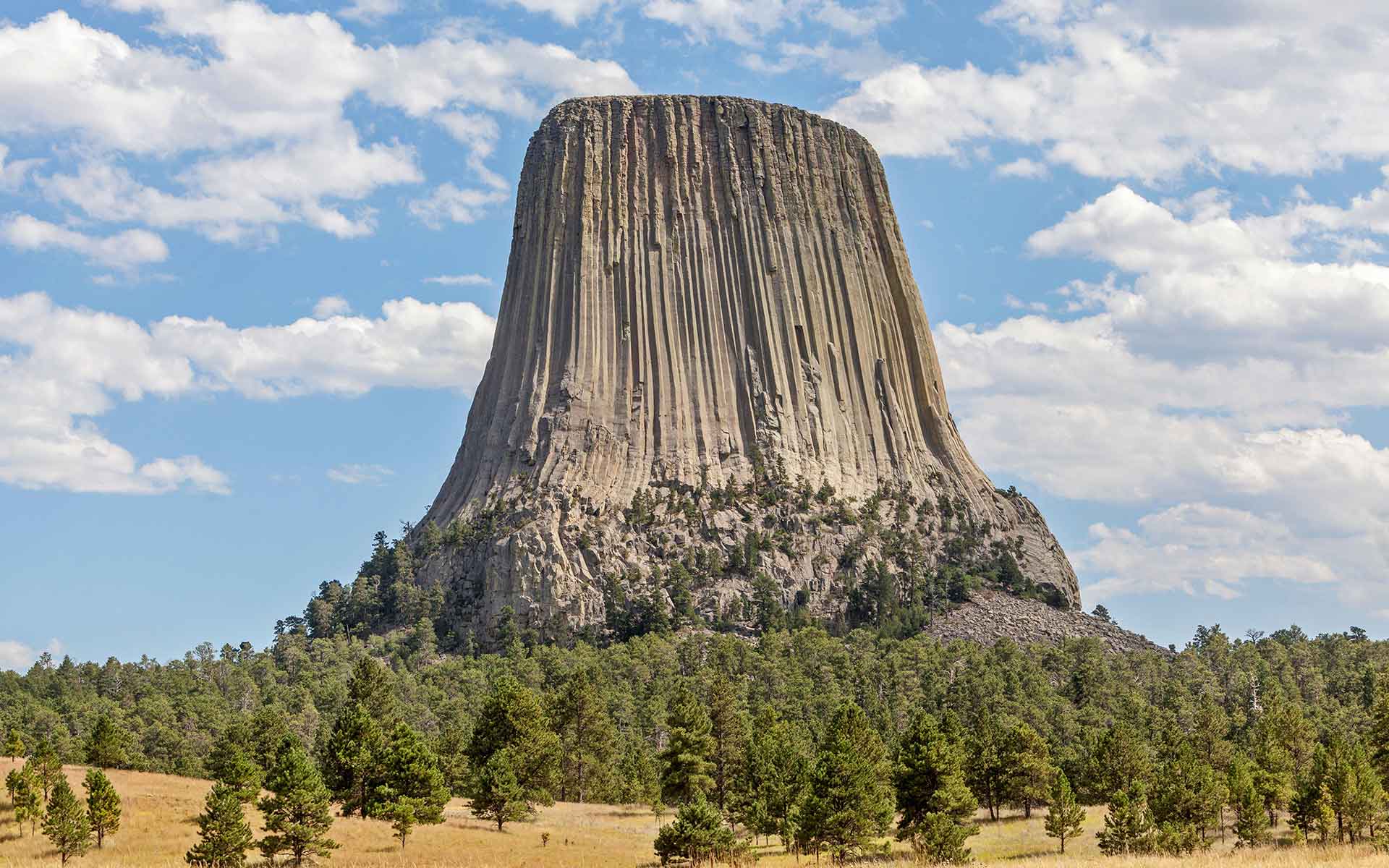
Overview of Mateo Tepe showing prominent ‘pillar-like’ relief above the surrounding plain; the vertical lineation of the columnar jointing is also apparent (image from Alamy).
Geological Period
Paleogene
Main geological interest
Igneous and Metamorphic petrology
Geomorphology and active geological processes
Location
Wyoming, United States of America
44°35’25”N, 104°42’53”W
Overview of Mateo Tepe showing prominent ‘pillar-like’ relief above the surrounding plain; the vertical lineation of the columnar jointing is also apparent (image from Alamy).
An iconic and prominent igneous rock feature with the World´s largest example of columnar jointing.
Mateo Tepe (Devils Tower) is an iconic geological feature and an example of what is called a self-voiced proturberance. As an iconic and prominent igneous rock feature, it is the World´s largest example of columnar jointing. Dramatically rising from a flat landscape, it is the most geologically and culturally important component of the topography for hundreds of kilometers. While there are a number of geological and culturally derived reconstructions of its formation, meaning, and appropriate management (Brady, 1999; Hanson and Moore, 1999; Jenkins, 2013), the tall polygonal columns are generally viewed as being paths to another dimension made by a spiritual bear.
- Geological description
Mateo Tepe (or Devils Tower, and also known as Bear Lodge) is a high-relief igneous rock mega-columnar formation (Figure 1) rising some 386 m above the valley of the nearby Belle Fourche River. It is comprised of porphyritic phonolite, and is the World’s largest example of polygonal columnar jointing (Robinson, 1956). On its lower slopes the Tower is flanked by an apron of talus deposits. There are a number of theories as to its geologic origin including volcanic plug, stock origin, laccolith origin, or maar-diatreme origin (Dutton and Schwartz, 1936); at present, our preferred model is that it is an exhumed volcanic neck that intruded the sedimentary rock sequence about 40.5 Ma ago (Bassett, 1961). However recently, Závada et al. (2015) plausibly suggest an origin as a lava coulée emplaced into a maar-diatreme volcano. Geomorphically, it formed as a resistant rock body as the enclosing and overlying softer Mesozoic sedimentary rock formations of sandstone, shale, and gypsum were eroded away. Mateo Tepe is a sacred place to over 20 Native American tribes and was inscribed as America’s first national monument in 1906 by President Theodore Roosevelt.
- Scientific research and tradition
Aside from geological investigations cited above, Mateo Tepe also has been researched in relation to its archaeological content and its relationship to adjoining regions. The Tower is considered sacred by Northern Plains Indians and many oral histories and sacred narratives connect indigenous peoples with the site, including the Arapaho, Crow, Cheyenne, Shoshone, and Lakota.
- Reference
Bassett, W.A. (1961) ‘Potassium-Argon Age of Devils Tower, Wyoming’, Science, 134, p. 1373. Available at: https://doi.org/10.1126/science.134.3487.1373.
Brady, J. (1999) ‘“Land Is Itself a Sacred, Living Being”: Native American Sacred Site Protection on Federal Public Lands Amidst the Shadows of Bear Lodge’, American Indian Law Review, 24(1), p. 153.
Dutton, C.E. and Schwartz, G.M. (1936) ‘Notes on the Jointing of the Devil’s Tower, Wyoming’, The Journal of Geology, 44(6), pp. 717–728. Available at: https://doi.org/10.1086/624472.
Hanson, J.R. and Moore, D. (1999) ‘Applied Anthropology at Devils Tower National Monument’, Plains Anthropologist, 44(170), pp. 53–60. Available at: https://doi.org/10.1080/2052546.1999.11931965.
Jenkins, M. (2013) ‘Devils Tower, Sacred Space’, Virginia Quarterly Review, 89(1), pp. 232–237.
Robinson, C.S. (1956) Geology of Devils Tower National Monument, Wyoming. 1021–I. U.S. Geological Survey, pp. 289–302. Available at: https://doi.org/10.3133/b1021I.
Závada, P. et al. (2015) ‘Devils Tower (Wyoming, USA): A lava coulée emplaced into a maar-diatreme volcano?’, Geosphere, 11(2), pp. 354–375. Available at: https://doi.org/10.1130/GES01166.1.
- Author(s)
Richard Stoffle.
University of Arizona, USA.
Kathleen van Vlack.
Northern Arizona University, USA.
Vic Semeniuk.
Adjunct Professor of Research|College of Science, Health, Engineering and Education, Discipline Environmental and Conservation Sciences. Murdoch University, Western Australia, Australia.
Margaret Brocx.
Adjunct Professor of Research|College of Science, Health, Engineering and Education, Discipline Environmental and Conservation Sciences. Murdoch University, Western Australia, Australia.


